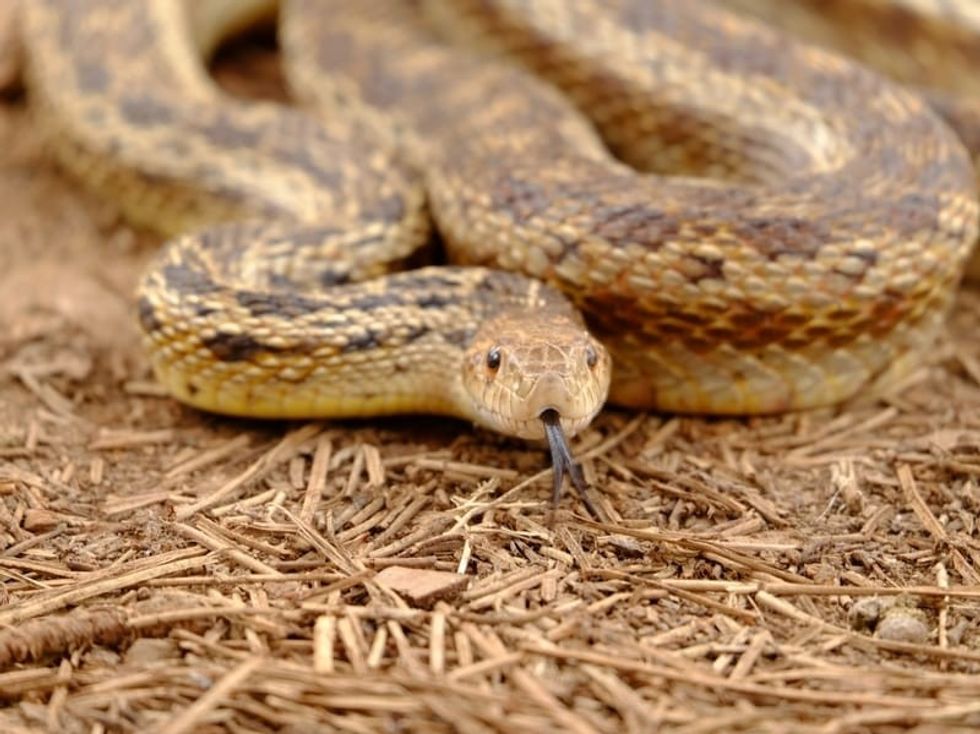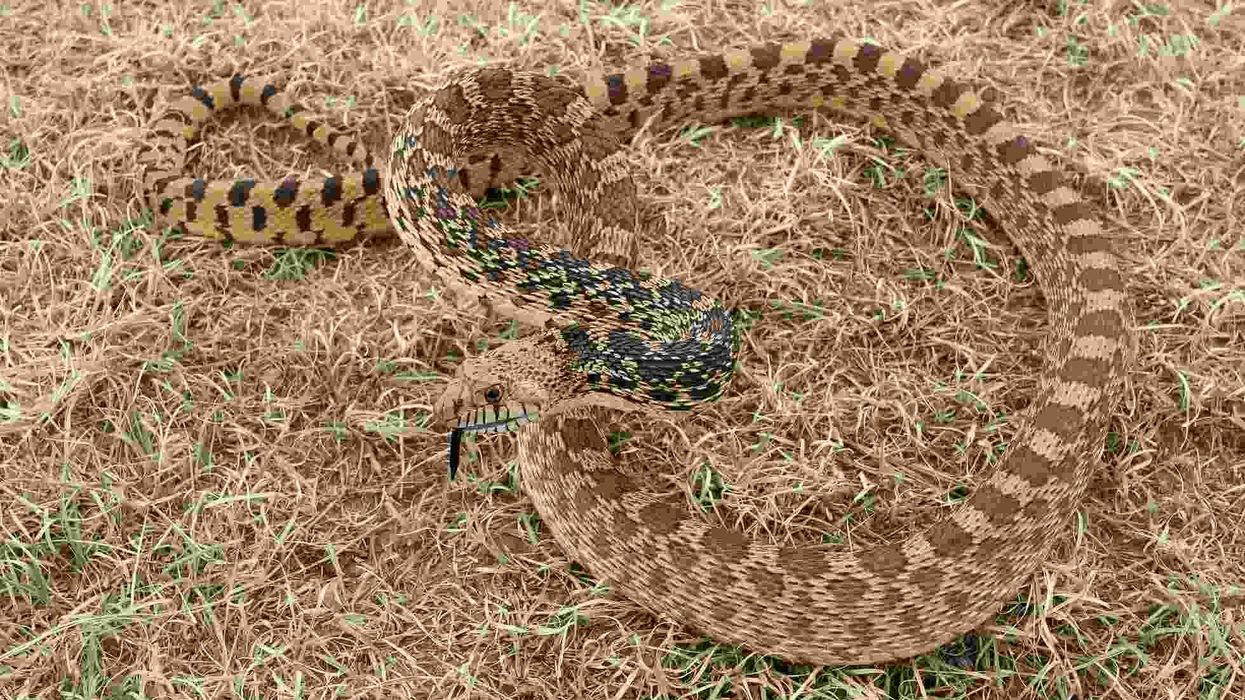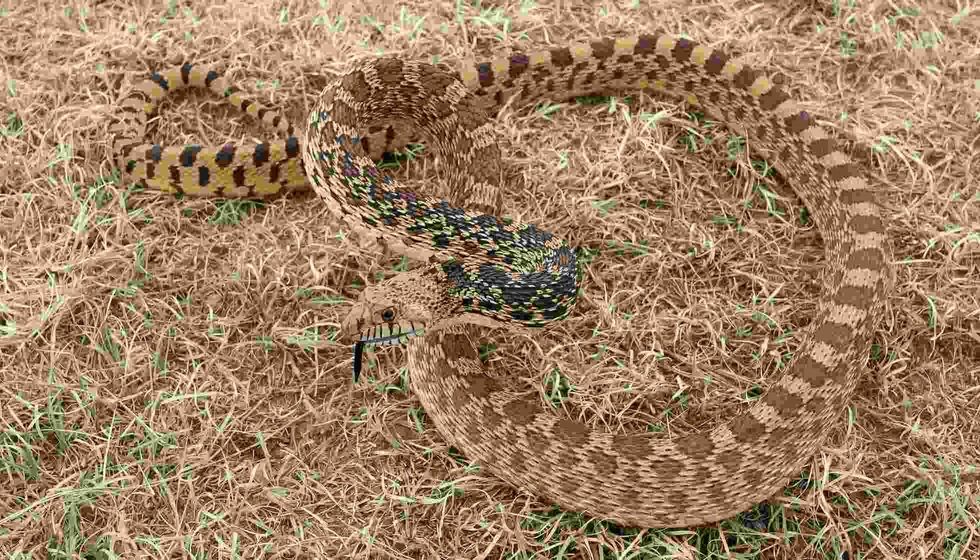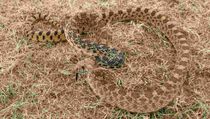Fun Gopher Snake Facts For Kids

Content
- What type of animal is a gopher snake?
- What class of animal does a gopher snake belong to?
- How many gopher snakes are there in the world?
- Where does a gopher snake live?
- What is a gopher snake's habitat?
- Who do gopher snakes live with?
- How long does a gopher snake live?
- How do they reproduce?
- What is their conservation status?
- What do gopher snakes look like?
- How cute are they?
- How do they communicate?
- How big is a gopher snake?
- How fast can a gopher snake run?
- How much does a gopher snake weigh?
- What are their male and female names of the species?
- What would you call a baby gopher snake?
- What do they eat?
- Are they poisonous?
- Would they make a good pet?
- Did you know...
- Why are gopher snakes important to their ecosystem?
- How do gopher snakes protect themselves from danger?
Are you interested in knowing more about snakes that hail from North America? If yes, then you have come to the right place to know about one of the most interesting snake species, the Gopher snake (Pituophis catenifer).
This non-venomous snake is mostly known for its rattlesnake-like look and its ability to perform mimicry of the rattlesnake to escape predators. The Pituophis catenifer is known for its diverse habitat that spans several areas of Canada, the USA, and Mexico.
Common subspecies of the snakes include the Great basin Gopher snake, the Pacific Gopher snake, the Baja California Gopher snake, the Arizona Gopher snake, and the Sonoran Gopher snake. The females and males of the Gopher snake species look alike.
These snakes can be active during the daytime or the nighttime. The Gophers especially love to feed on rodents.
The Gopher snake has been a blessing for those farmers who were frustrated with the rodent population in their farmland. Interestingly, the Gopher snakes happen to have a long lifespan in captivity, and one fellow managed to reach 33 years.
The calm personality of these snakes has also made them a go-to pet for those who like snakes. Keep on reading to know more Gopher snake facts.
Also, check out the articles on the Cottonmouth snake and Copperhead snake to know more about the mysterious lives of snakes.
Gopher Snake Interesting Facts
What type of animal is a gopher snake?
The Gopher snake (Pituophis catenifer) is a type of non-venomous snake.
What class of animal does a gopher snake belong to?
Like other snakes, the Gopher snake also belongs to the class Reptilia. The Gopher snakes (Pituophis catenifer) also belong to the genus Pituophis that they share with bullsnakes and pine snakes.
How many gopher snakes are there in the world?
The Gopher snake (Pituophis catenifer) is a widely available species, so it is hard to track down their whole population. According to the International Union for Conservation of Nature (IUCN), their status is currently of Least Concern.
Where does a gopher snake live?
The Gopher snakes are known for having a geographical range and habitat that stretches from the Southwestern side of Canada to the northern side of New Mexico. They are also found in different states of Mexico as well as of the USA.
In the US, the Gopher snakes are mostly found on the Pacific coast. Other than the land variants, some subspecies have also been seen in islands. In total, 11 subspecies of Gopher snakes have been identified.
The P.c. vertebralis subspecies is found in the southern part of Baja, California.
What is a gopher snake's habitat?
The Gopher snake (Pituophis catenifer) has the ability to adapt to different types of habitats. the Gopher snake habitat ranges from woodlands, deserts, shrublands, agricultural areas, chaparral, and prairies.
So, if you are in the Northern American Gopher snake range, you can definitely spot them, but you may need to look a little harder because they are usually camouflaged. Sometimes they Gopher snakes may even visit marshes to forage, but they are not their choice of habitats.
These snakes are also good with swimming as well as climbing trees. When there is a lack of food, the Gopher snakes can also participate in periods of resting.
Who do gopher snakes live with?
Gopher snakes are solitary animals, so they live alone and may only come in contact with other Gopher snakes during the mating season. The Gopher snake can spend 90% of its life hidden in underground burrows. During the breeding season, the Gopher females may lay eggs in a communal den or burrow.
How long does a gopher snake live?
The average lifespan of the Gopher snakes is 12-15 years in the wild. However, there was one specimen in captivity that managed to live till 33 years old.
How do they reproduce?
The Gopher snakes (Pituophis catenifer) follow the sexual process of reproduction. They are oviparous in nature, so eggs are laid by female snakes. The males in the species compete amongst each other to reach the females.
There is a secretion from the body of the female Gopher snakes that attract the males into mating. June to August is the usual breeding time for these native North American Gopher snakes. As the Gopher snakes do not participate in monogamous pairings, they are free to mate with any prospective partners.
Even though Gopher snakes have only a single breeding season every year, some females may produce two broods. The clutch usually contains 2-15 eggs, but at times it can go up to 24 eggs.
The incubation period for eggs lasts for about 65-75 days, and the juvenile Gopher snake babies are left alone without getting any attention from their parents. In the Gopher snake species, the males reach sexual maturity at just 1.5 years after birth, while it may take four years for a female snake to reach maturity.
What is their conservation status?
According to the International Union for Conservation of Nature (IUCN) Red List, the snake has the status of being Least Concern. Even though these are non-venomous snakes, humans may often kill them as they mix them up with rattlesnakes as they have a similar look.
Gopher Snake Fun Facts
What do gopher snakes look like?
One of the most striking things about the Gopher snakes is their look. Their slender and long body has the perfect design to hide in different habitats, which is perfect as they are spread over a varied geographic range.
The appearance of a Gopher snake is quite simple with its light straw-colored body with dark splotches. The head of the Gopher snake is a little broader, but they have a narrow neck. Their similar look to that of the rattlesnake has given rise to the Gopher snake vs. Rattlesnake debate.
The Gopher snakes are able to produce a mimicry of the rattlesnakes to save themselves from predators. The color variation of the scales may also differ between their habitat.
The ventral surface of the Gopher snake may have a white or light yellowish tinge. A dark line follows their body from their face and crosses their eyes to finally reach the angle of the jaw.
Some blotched and striped variants have also been seen in the wild. As a non-venomous snake, the Gopher has a single anal plate. The snake also has keeled scales on its body.
You can observe 27-37 rows of scales in the midsection of the Gopher snake's body. The Sonoran Gopher snake is one of the subspecies of the Pituophis catenifer that has a body with big brown splotches.

How cute are they?
Would you really like to call a snake cute? Even if we do not call them cute, the Gopher snake species deserve to be called spectacular because of their magnificent look.
How do they communicate?
As we have mentioned before, the Gopher snakes are solitary animals. So, seldom do they need the ability to converse with other Gopher snakes. However, during the mating season, the females produce a secretion that lures the males to follow their duty of reproduction.
Hence, scent plays an important role in communication between the females and males of the species. The tongue of snakes is also quite helpful to assess and taste the surroundings. Vibrations are also used as a form of communication to know more about their environment.
How big is a gopher snake?
The average Gopher snake size is around 71-108.2 in (180-275 cm). Because of the long length of their body, the Gopher snake does need a longer place for living if they are kept in captivity.
If we compare between Bull snake vs Gopher snake, then both the snakes will have a similar body length as the Bullsnake manages to grow till 96 in (244 cm). The Bullsnake is also often clubbed as a subspecies of the Gopher snake.
How fast can a gopher snake run?
Like most other snakes, the Gopher snakes lack legs, so technically, they aren't able to run. However, they can indeed move fairly fast through the forest or desert where they are residing.
How much does a gopher snake weigh?
The average weight of a Gopher Snake is around 2-4 lb (1-2 kg). So, they have a lightweight body even though they have a long length.
What are their male and female names of the species?
There are no distinct names for the male and female of the Gopher snakes.
What would you call a baby gopher snake?
The baby Gopher snake is called a snakelet or a hatchling.
What do they eat?
Well, the very name Gopher snake comes from their habit of eating Gophers that are small mammals. However, other than that, the Gopher snake diet may also include rabbits, mice, rats, lizards, birds, eggs, and even insects.
The Gopher snake captures and constricts its prey before eating them. The primary prey for the Gopher snake will depend on their choice of habitats. Sometimes the Gopher snake may also prey on bats.
The amount of food eaten by a snake will depend on its size and weight. So, if you have got a Gopher, take them to the doctor for a thorough checkup, and they will help you with the amount of food that the snake will need.
Are they poisonous?
No, calling a Gopher Snake venomous isn't a thing as they do not produce venom. However, the Gopher snake bite can be pretty impactful and they often use it to hit their prey as well as their predators.
Would they make a good pet?
Gopher snakes are intelligent snakes, and they have done well in captivity. The snake can live a long life in captivity if it is given a suitable habitat.
In the wild, the Gopher snake often has to face predators that they avoid while being a pet. However, you should always check with the species being legal to keep as a pet.
It is best to have a conversation with the local authority to check if there are any guidelines related to keeping Gopher snakes. Some apartments and buildings may also have restrictions against keeping a snake, so keeping them in mind helps in protecting the animal.
One of the most important things about keeping a pet is to care for them. Also, Gopher snake bites can be painful because of the sharp Gopher snake teeth.
So, as the owner, you will need to be extra careful. Gopher snake care will include giving them a favorable habitat that is neither too hot nor too cold.
As Gopher snakes tend to be big, you should make sure that they have enough space. Also, it is better to get a Gopher snake that has been bred in captivity rather than picking one up from the wild.
Catching a Gopher can be a little tricky because of its bite. Try to follow the usual instruction for catching a snake which often involves pinning down the head of a snake before they are caught.
An adult Gopher snake may require a 40-gallon tank. Wood shavings and paper are the best substrates that can be used to mimic deserts that are a favorite habitat for the Gopher snakes.
The species also need a place to hide that is away from the light. As the Gopher snake lifespan is fairly long, you should be ready to take care of them for a long while.
If you happen to have a male and a female Gopher snake, it is better to keep them separate to avoid any kind of conflict.
Also, provide them a soaking dish where they can fully submerge themselves to have a comfortable stay. One of the most sought-after Gopher snakes is the Albino Gopher snake, and its mating usually takes place in captivity.
Did you know...
Some other subspecies of the Gopher snake include the Santa Cruz gopher snake, and the San Diego gopher snake.
Why are gopher snakes important to their ecosystem?
Gopher snakes and their subspecies do play an important role in controlling the number of rodents present in the wild. Also, their name is derived from the snake's habit of eating Gophers that can often be pesky animals that wreak havoc on crops.
So, the Gopher snakes can work out great for a farmer to get rid of small mammals that feed on their crops.
How do gopher snakes protect themselves from danger?
The most iconic move of the Gopher snake is to mimic the moves of the Rattlesnakes. Both the snakes also have a similar look because of their dark spots.
When perceiving threat, the Gopher snakes inflate their body, hiss, and try to imitate the rattle-like sound of the rattlesnakes by brushing themselves on dry vegetation. Gopher snakes may even shake its tail like rattlesnakes to unsuspecting people.
Humans have often mistaken the Gopher snakes as real Rattlesnakes, which have cost the snakes their life. However, if the mimicry doesn't seem to work, the Gopher snakes do use a strong painful non-venomous bite to attack their predators, which can also be humans.
Here at Kidadl, we have carefully created lots of interesting family-friendly animal facts for everyone to discover! Learn more about some other reptiles including green anaconda, or yellow anaconda.
You can even occupy yourself at home by drawing one on our Ghoper snake coloring pages.
We Want Your Photos!
More for You
Bachelor of Arts specializing in Journalism and Mass Communication, Postgraduate Diploma in Sports Management

Moumita DuttaBachelor of Arts specializing in Journalism and Mass Communication, Postgraduate Diploma in Sports Management
A content writer and editor with a passion for sports, Moumita has honed her skills in producing compelling match reports and stories about sporting heroes. She holds a degree in Journalism and Mass Communication from the Indian Institute of Social Welfare and Business Management, Calcutta University, alongside a postgraduate diploma in Sports Management.
Bachelor of Law

Abdulqudus MojeedBachelor of Law
A versatile professional with a passion for creative writing and technology. Abdulqudus is currently pursuing his Bachelor of Law from the University of Lagos and has experience as a tutor, intern assistant, and volunteer. He possesses strong organizational skills and is a detail-oriented person.
Disclaimer
1) Kidadl is independent and to make our service free to you the reader we are supported by advertising. We hope you love our recommendations for products and services! What we suggest is selected independently by the Kidadl team. If you purchase using the Buy Now button we may earn a small commission. This does not influence our choices. Prices are correct and items are available at the time the article was published but we cannot guarantee that on the time of reading. Please note that Kidadl is a participant in the Amazon Services LLC Associates Program, an affiliate advertising program designed to provide a means for sites to earn advertising fees by advertising and linking to Amazon. We also link to other websites, but are not responsible for their content.
2) At Kidadl, we strive to recommend the very best activities and events. We will always aim to give you accurate information at the date of publication - however, information does change, so it’s important you do your own research, double-check and make the decision that is right for your family. We recognise that not all activities and ideas are appropriate for all children and families or in all circumstances. Our recommended activities are based on age but these are a guide. We recommend that these ideas are used as inspiration, that ideas are undertaken with appropriate adult supervision, and that each adult uses their own discretion and knowledge of their children to consider the safety and suitability. Kidadl cannot accept liability for the execution of these ideas, and parental supervision is advised at all times, as safety is paramount. Anyone using the information provided by Kidadl does so at their own risk and we can not accept liability if things go wrong.
3) Because we are an educational resource, we have quotes and facts about a range of historical and modern figures. We do not endorse the actions of or rhetoric of all the people included in these collections, but we think they are important for growing minds to learn about under the guidance of parents or guardians.







